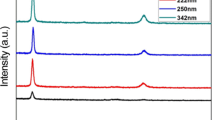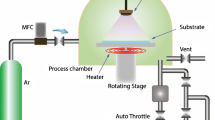Abstract
Zinc oxide (ZnO) thin films have been deposited on Si substrate and glass substrate using thermal evaporation, pulsed laser deposition (PLD) and radio-frequency (RF) sputtering methods. The structural, surface morphological, optical and electrical properties of ZnO thin films deposited by these three methods were investigated and compared systematically using x-ray diffractometer, atomic force microscopy, ellipsometric and current–voltage (I–V) measurement. The ZnO films deposited by RF sputtering method were highly oriented along the (002) plane. The ZnO films grown by thermal evaporation and PLD methods exhibited a polycrystalline nature. The surface roughness was found to be the least and the transparency in the visible region was the highest for the films grown by the RF sputtering method as compared to the films grown by the other two methods. The I–V characteristics reveal that the Pd:Au/ZnO (RF-sputtered) Schottky contact exhibited a better value of ideality factor, series resistance and barrier height as compared to the values obtained for Pd:Au/ZnO (thermally evaporated and pulse laser-deposited) Schottky contacts. The optical bandgap was found to be almost the same for the films grown by all three methods and was estimated to be around 3.2 eV.
Similar content being viewed by others
References
U. Ozgur, D. Hofstetter, and H. Morkoc, Proc. IEEE 98, 1255 (2010).
Y. Choi, J. Kang, D. Hwang, S. Park, and I.E.E.E. Trans, Electron Devices 57, 26 (2010).
G.M. Ali, S. Singh, and P. Chakrabarti, J. Nanoelectron. Optoe. 4, 3 (2009).
T.W. Kim, D.C. Choo, Y.S. No, W.K. Choi, and E.H. Choi, Appl. Surf. Sci. 253, 1917 (2006).
K.M. Lin and P. Tsai, Mater. Sci. Eng. B,139, 81 (2007).
S. Singh, R. Nunna, C. Periasamy, and P. Chakrabarti, Int. J. Contemp. Res. Eng. Technol. 1, 114 (2011).
S. Singh and P. Chakrabarti, J. Nanosci. Nanotechnol. 11, 1 (2011).
L. Brillson and Y. Lu, J. Appl. Phys. 109, 121301 (2011).
T. Krajewski, E. Guziewicz, M. Godlewski, L. Wachnicki, I.A. Kowalik, A. Wojcik-Glodowska, M. Lukasiewicz, K. Kopalko, V. Osinniy, and M. Guziewicz, Microelectron. J. 40, 253 (2009).
J.J. Ding, S.Y. Ma, H.X. Chen, X.F. Shi, T.T. Zhou, and L.M. Mao, Phys. B 404, 2439 (2009).
C. Periasamy, R. Prakash, and P. Chakrabarti, J. Mater. Sci: Mater. Electron. 21, 309 (2010).
C. Periasamy and P. Chakrabarti, J. Eletron. Mater. 40, 259 (2011).
S. Singh and P. Chakrabarti, Superlattices Microstruct. 64, 289 (2013).
S. Venkatachalam, Y. Iida, and Y. Kanno, Superlattices Microstruct. 44, 127 (2008).
R.E. Marotti, C.D. Bojorge, E. Broitman, H.R. Canepa, J.A. Badan, E.A. Dalchiele, and A.J. Gellman, Thin Solid Films 517, 1077 (2008).
G. Weissler and R. Carlson, eds., Vacuum Physics and Technology, Vol. 14 (New York: Academic Press, 1980), pp. 572–573.
J. Tauc, R. Grigorovich, and A. Vancu, Phys. Stat. Sol. 15, 627 (1966).
D. Somvanshi and S. Jit, J. Nanoelectron. Optoe. 9, 1 (2014).
Acknowledgement
The authors gratefully acknowledge the facilities provided by the Centre for Interdisciplinary Research (CIR), Motilal Nehru National Institute of Technology, Allahabad.
Author information
Authors and Affiliations
Corresponding author
Rights and permissions
About this article
Cite this article
Vyas, S., Giri, P., Singh, S. et al. Comparative Study of As-Deposited ZnO Thin Films by Thermal Evaporation, Pulsed Laser Deposition and RF Sputtering Methods for Electronic and Optoelectronic Applications. J. Electron. Mater. 44, 3401–3407 (2015). https://doi.org/10.1007/s11664-015-3861-y
Received:
Accepted:
Published:
Issue Date:
DOI: https://doi.org/10.1007/s11664-015-3861-y




